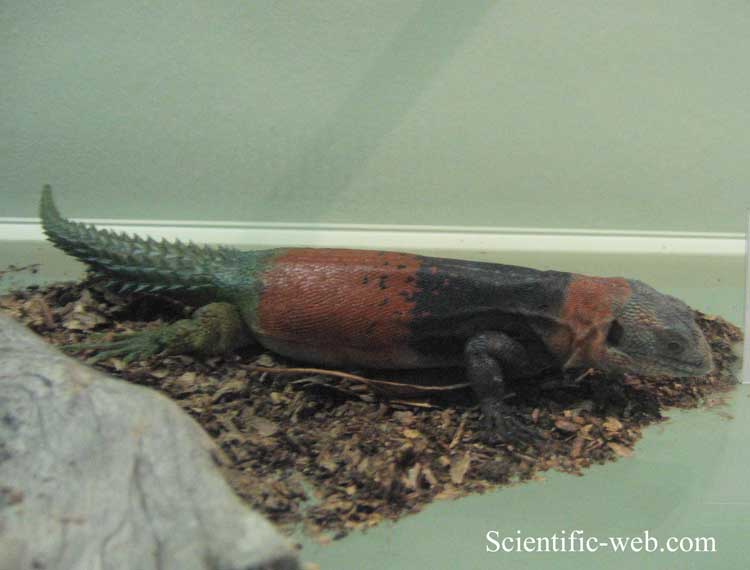
Cachryx alfredschmidti, Photo: Michael Lahanas
Superregnum: Eukaryota
Cladus: Unikonta
Cladus: Opisthokonta
Cladus: Holozoa
Regnum: Animalia
Subregnum: Eumetazoa
Cladus: Bilateria
Cladus: Nephrozoa
Superphylum: Deuterostomia
Phylum: Chordata
Subphylum: Vertebrata
Infraphylum: Gnathostomata
Megaclassis: Osteichthyes
Cladus: Sarcopterygii
Cladus: Rhipidistia
Cladus: Tetrapodomorpha
Cladus: Eotetrapodiformes
Cladus: Elpistostegalia
Superclassis: Tetrapoda
Cladus: Reptiliomorpha
Cladus: Amniota
Classis: Reptilia
Cladus: Eureptilia
Cladus: Romeriida
Subclassis: Diapsida
Cladus: Sauria
Infraclassis: Lepidosauromorpha
Superordo: Lepidosauria
Ordo: Squamata
Cladus: Unidentata, Episquamata
Cladus: Toxicofera
Subordo: Iguania
Infraordo: Pleurodonta
Familia: Iguanidae
Genera: Cachryx
Species: Cachryx alfredschmidti
Cachryx alfredschmidti (Köhler, 1995)
Published in: Köhler, & Gunther. Zwei neue Schwarzleguane aus Honduras und Mexiko.
source: The Reptile Database
Campeche Spiny-tailed Iguana In English
Basionym: Ctenosaura alfredschmidti Köhler, 1995
The Campeche spiny-tailed iguana (Cachryx alfredschmidti)[1] is a species of lizard in the family Iguanidae. The species is native to southeastern Mexico and adjacent Guatemala.[3]
Etymology
The specific name, alfredschmidti, is in honor of German herpetoculturist Alfred Schmidt.[3][4]
Description
Adult males of C. alfredschmidti reach at least 170 mm (6.7 in) and females 152 mm (6.0 in) in snout-to-vent length (SVL).[2] Tail length varies from 74 %[5] to 85% SVL.[2]
Geographic range
C. alfredschmidti was thought to be endemic to southern Campeche in Mexico.[1][2] However, in 2003, this species was also recorded by a scientific expedition to the Mirador-Río Azul National Park in the Petén Department in Northern Guatemala. This was the first record in Guatemala's herpetofauna for this species.[5]
Habitat
The natural habitat of C. alfredschmidti is tropical moist lowland forest[1] and seasonally flooded scrub forest.[5]
Behavior
C. alfredschmidti is arboreal.[1] It can find safety in hollow branches and tree trunks, blocking the entrance with its spiny tail.[2][5]
Diet
Fecal samples suggests that the diet of C. alfredschmidti consists of leaves, though it probably will eat arthropods too.[2]
Reproduction
C. alfredschmidti is oviparous.[3]
Conservation status
C. alfredschmidti is potentially threatened by habitat loss and degradation.[1] The Guatemalan population was found in the Mirador-Río Azul National Park.[5]
References
Köhler G [in French] (2004). "Ctenosaura alfredschmidti ". IUCN Red List of Threatened Species. 2004: e.T44180A10856950. doi:10.2305/IUCN.UK.2004.RLTS.T44180A10856950.en.
Köhler G (1995). "Eine neue Art der Gattung Ctenosaura (Sauria: Iguanidae) aus dem südlichen Campeche, Mexico" [A new species of the genus Ctenosaura (Sauria: Iguanidae) from southern Campeche, Mexico]. Salamandra. 31 (1): 1–14. (Ctenosaura alfredschmidti, new species). (in German).
Cachryx alfredschmidti at the Reptarium.cz Reptile Database. Accessed 2 August 2017.
Beolens, Bo; Watkins, Michael; Grayson, Michael (2011). The Eponym Dictionary of Reptiles. Baltimore: Johns Hopkins University Press. xiii + 296 pp. ISBN 978-1-4214-0135-5. (Ctenosaura alfredschmidti, p. 5).
Radachowsky J, García Anleu R, Köhler G (2004). "First record of Ctenosaura alfredschmidti Köhler, 1995 in Guatemala". Salamandra. 40 (1): 11–13.
Further reading
Malone CL, Reynoso VH, Buckley L (2017). "Never judge an iguana by its spines: Systematics of the Yucatan spiny tailed [sic] iguana, Ctenosaura defensor (Cope, 1866)". Molecular Phylogenetics and Evolution 115: 27–39. (Cachryx alfredschmidti, new combination).
Morales-Mávil JE, Bello-Sánchez EA, Corona-López CR (2016). "Distribution and Natural History of the Campeche Spiny-tailed Iguanas [sic] (Ctenosaura alfredschmidti)". Herpetological Conservation and Biology 11 (Monograph 6): 168–176. (in English, with an abstract in Spanish).
Retrieved from "http://en.wikipedia.org/"
All text is available under the terms of the GNU Free Documentation License

